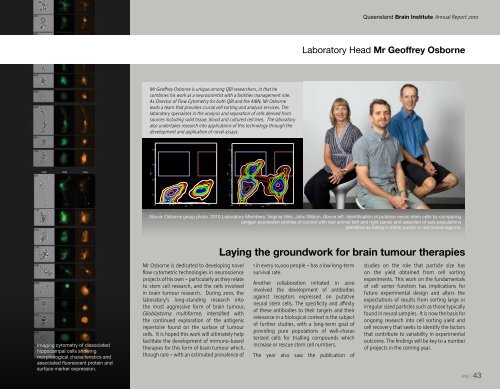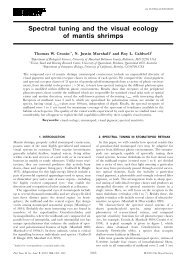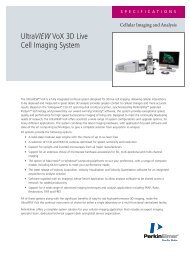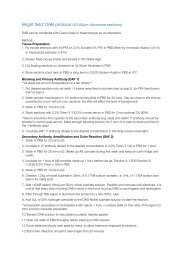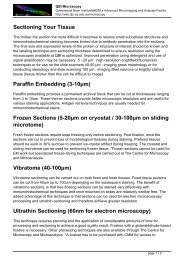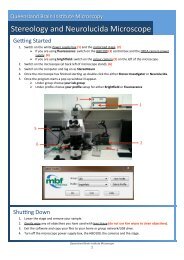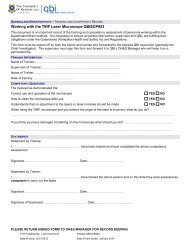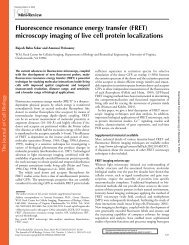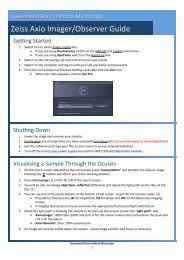Queensland Brain Institute 2010 Annual Report - University of ...
Queensland Brain Institute 2010 Annual Report - University of ...
Queensland Brain Institute 2010 Annual Report - University of ...
Create successful ePaper yourself
Turn your PDF publications into a flip-book with our unique Google optimized e-Paper software.
<strong>Queensland</strong> <strong>Brain</strong> <strong>Institute</strong> <strong>Annual</strong> <strong>Report</strong> <strong>2010</strong>Laboratory Head Mr Ge<strong>of</strong>frey OsborneMr Ge<strong>of</strong>frey Osborne is unique among QBI researchers, in that hecombines his work as a neuroscientist with a facilities management role.As Director <strong>of</strong> Flow Cytometry for both QBI and the AIBN, Mr Osborneleads a team that provides crucial cell sorting and analysis services. Thelaboratory specialises in the analysis and separation <strong>of</strong> cells derived fromsources including solid tissue, blood and cultured cell lines. The laboratoryalso undertakes research into applications <strong>of</strong> this technology through thedevelopment and application <strong>of</strong> novel assays.10 510 510 410 4PE-APE-A10 310 310 210 2-650 0 650 10 3 10 4 10 5GFP-650 0 650 10 3 10 4 10 5GFPAbove: Osborne group photo. <strong>2010</strong> Laboratory Members: Virginia Nink, John Wilson. Above left: Identification <strong>of</strong> putative neural stem cells by comparingantigen expression pr<strong>of</strong>iles <strong>of</strong> control with test animal (left and right panel) and selection <strong>of</strong> sub-populationsidentified as falling in either purple or red boxed regions.Imaging cytometry <strong>of</strong> dissociatedhippocampal cells showingmorphological characteristics andassociated fluorescent protein andsurface marker expression.Mr Osborne is dedicated to developing novelflow cytometric technologies in neuroscienceprojects <strong>of</strong> his own – particularly as they relateto stem cell research, and the cells involvedin brain tumour research. During <strong>2010</strong>, thelaboratory’s long-standing research intothe most aggressive form <strong>of</strong> brain tumour,Glioblastoma multiforme, intensified withthe continued exploration <strong>of</strong> the antigenicrepertoire found on the surface <strong>of</strong> tumourcells. It is hoped this work will ultimately helpfacilitate the development <strong>of</strong> immuno-basedtherapies for this form <strong>of</strong> brain tumour which,though rare – with an estimated prevalence <strong>of</strong>Laying the groundwork for brain tumour therapies1 in every 10,000 people – has a low long-termsurvival rate.Another collaboration initiated in <strong>2010</strong>involved the development <strong>of</strong> antibodiesagainst receptors expressed on putativeneural stem cells. The specificity and affinity<strong>of</strong> these antibodies to their targets and theirrelevance in a biological context is the subject<strong>of</strong> further studies, with a long-term goal <strong>of</strong>providing pure populations <strong>of</strong> well-characterizedcells for trialling compounds whichincrease or rescue stem cell numbers.The year also saw the publication <strong>of</strong>studies on the role that particle size hason the yield obtained from cell sortingexperiments. This work on the fundamentals<strong>of</strong> cell sorter function has implications forfuture experimental design and alters theexpectations <strong>of</strong> results from sorting large orirregular sized particles such as those typicallyfound in neural samples. It is now the basis forongoing research into cell sorting yield andcell recovery that seeks to identify the factorsthat contribute to variability in experimentaloutcome. The findings will be key to a number<strong>of</strong> projects in the coming year.PG | 43


